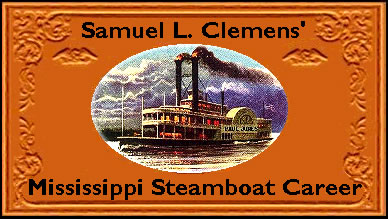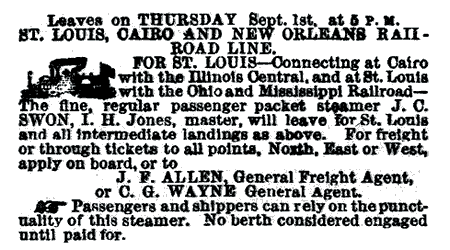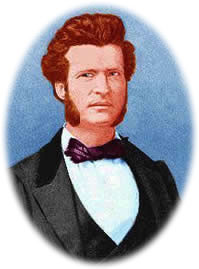 |
|
| AS LICENSED PILOT |
Boats piloted by Clemens after he received his official Pilot's License in April 1859 include:
Steamboat: ALFRED T. LACEY
Built: 1857
Clemens' Service: 4 - 21 May 1859
Co-Pilot: Barton Bowen
Captain: John P. Rodney
Fate: burned April 26, 1860 with loss of sixteen lives including Captain
A. T. Lacy's daughter
Steamboat: RUFUS J. LACKLAND
Built: 1857
Tonnage: 710
Clemens' Service: 9 July - 30 July 1859
Captain: William B. Miller
Fate: Obtained by Confederacy in 1861 and sunk in shallow stretch of
Yazoo River to block Union traffic.
Clemens' comments: I took lodgings at Mrs. Marmadale's,
John, higher up in Locust street, towards the big church--I mean the one in
the construction of which the least little bit in the world of Christian vanity
sticks out--for, do you know, John, that that edifice reminds me of the steamers
JOHN J. ROE and R. J. LACKLAND? Yes, she does. You admire the craft at a distance,
but when you step aboard you are astonished to find that what you thought
was all cabin, isn't and what you thought was all church, isn't, either, by
considerably more than a good deal. No, John, it's all sham. There's a bulkhead
amidships, and behind is a place devoted to bale-rope and buckets, in the
one case, and prayer-meeting in the other.
- "Soleather Cultivates His Taste for Music," New Orleans Crescent,
21 July 1859 (signed by "Soleather"; identified by Edgar Branch
as Samuel Clemens).
|
NOTE: Edgard Branch had originally dated Clemens' service on the RUFUS J. LACKLAND as 11 July - 3 August 1857. Further research by Michael Marleau, includes a new interpretation of Clemens' personal journals and indicates the 1859 dates are the most likely dates of service for the RUFUS J. LACKLAND. Based on circumstantial evidence alone, Branch had previously theorized that during this time frame Clemens had piloted: Steamboat: J. C. SWON
|
Steamboat: EDWARD J. GAY
Built: 1859
Tonnage: 823
Clemens' Service: 2 August - 1 October 1859
Captain: Barton Bowen
Fate: 1863 acquired by Confederacy and taken up Yalobusha River; later burned on 17 July 1863 to prevent capture.
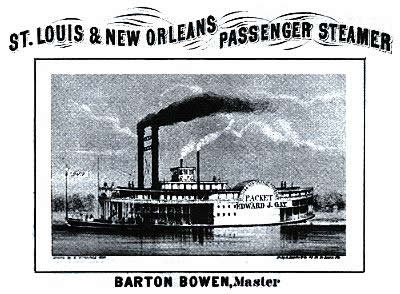
For an anecdote regarding the EDWARD J. GAY, see Major Jack Downing's reminiscences.
For a day by day account of Clemens' time on the EDWARD J. GAY
which ended in tragedy, see Michael Marleau's Tragedy
on the Mississippi.
Steamboat: A. B. CHAMBERS
Built: 1855
Tonnage: 410
Clemens' Service: 26 October 1859 - 24 February 1860
Co Pilots: James DeLancey and William Bowen
First mate: Grant Marsh
Captain: George Bowman
Fate: snagged and sank near St. Louis, 24 September 1860
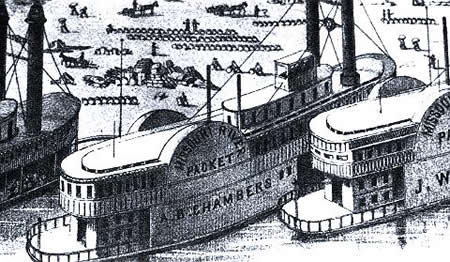
From the lithograph "Bird's Eye View of St. Louis"
drawn and published by James T. Palmatary in 1857.
From the Raymond Ewing collection.
Clemens' comments: The place where we long ago grounded
the A. B. Chambers has long ago ceased to be anything but sand with a little
water on top of it.
- Notebook #21 (April - May 1882) reprinted in Mark Twain's Notebooks &
Journals, Vol. II. Also see Grant Marsh.
Steamboat: CITY OF MEMPHIS
Built: 1857
Tonnage: 865
Clemens' Service: 25 March - 1 or 2 July 1860
Co-Pilot: Wesley Jacobs
Captain: Joseph Edward Montgomery
Fate: boilers exploded May 31, 1866 with loss of eleven lives; towed to Saint Louis, MO and dismantled
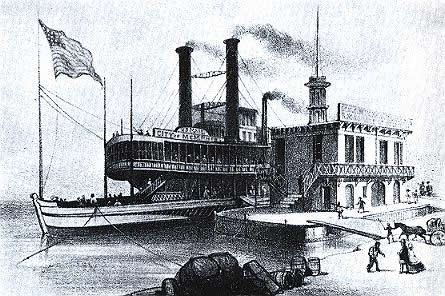
Clemens' comments: And I am also lucky in having a berth,
while all the young pilots are idle. This is the luckiest circumstance that
ever befell me. Not on account of the wages - for that is a secondary consideration
- but from the fact that the CITY OF MEMPHIS is the largest boat in the trade
and the hardest to pilot, and consequently I can get a reputation on her,
which is a thing I never could accomplish on a transient boat. I can "bank"
in the neighborhood of $100 a month on her, and that will satisfy me for the
present (principally because the other youngsters are sucking their fingers.)
Bless me! what a pleasure there is in revenge! and what vast respect Prosperity
commands! Why, six months ago, I could enter the "Rooms," and receive
only a customary fraternal greeting - but now they say, "Why, how are
you, old fellow - when did you get in?"
- Letter to Orion Clemens, June 1860
One time I mistook Capt. Ed Montgomery's coat hanging on the
big bell for the Capt. himself and waiting for him to tell me to back I ran
into a steamboat at New Orleans.
- Mark Twain's Notebooks & Journals, Vol. 2
Steamboat: ARAGO
Built: 1860
Tonnage: 268
Clemens' Service: 28 July - 31 August 1860
Co-Pilot: Isaiah W. "Bill" Hood
[identification of "Bill" Hood was made by researcher Michael Marleau, Nov. 2006]
Captain: George P. Sloan
Fate: Burned in Dog Tooth Bend, near Commerce, MO on Feb. 6, 1865.
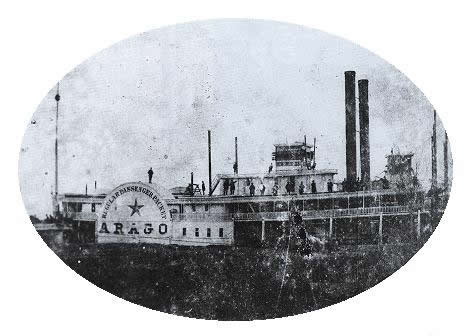
Clemens' comments: Pilot's Memoranda: Steamer ARAGO left
New Orleans on Wednesday, August 22, at 3 P.M. . . . The agents in New Orleans
informed the pilots of this boat that "they considered the fact that
freights were not so rotten property, as pretty well established." Amen!
- Missouri Republican, 30 August 1860; reprinted in Early Tales
and Sketches, Vol. 1
Steamboat: ALONZO CHILD
Built: 1857
Tonnage: 493
Clemens' Service: 19 September 1860 - 18 November 1860
and 8 January 1861 - 8 May 1861
Co-Pilots: Horace Bixby, William Bowen, Sam Brown
Captains: David DeHaven and James O'Neal
Fate: 1861 acquired by Confederacy and taken up Yazoo River to prevent capture. Parts of the boat were salvaged for use on the Confederate ram TENNESSEE; later acquired by the U. S. Navy in September 1863 but not recommissioned.
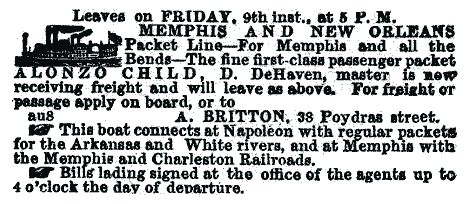
Ad for the ALONZO CHILD from 1861
Clemens' comments: I grounded the "Child" on
the bank, at nearly flood-tide, where we had to stay until the "great"
tide ebbed and flowed again (24 hours,) before she floated off.
- Letter
to Orion Clemens, 21 November 1860
Ma was delighted with her trip, but she was disgusted with the
girls for allowing me to embrace and kiss them--and she was horrified at the
Schottische as performed by Miss Castle and me. She was perfectly willing
for me to dance until 12 o'clock at the imminent peril of my going to sleep
on the after watch--but then she would top off with a very inconsistent sermon
on dancing in general; ending with a terrific broadside aimed at the heresy
of heresies, the Schottische.
- Letter
to Orion Clemens, 18 March 1861
Why in the mischief don't O'Neil die? Is that d----d old Fenian
going to live forever? . . . You ought to have seen him & me bring the
(d--n the boat's name, I can't think of it now - Alonzo, or Child, or something
like that,) up the river through the ice, drawing all the water. He was the
whitest Captain I ever sailed with, & in this stiff "earthquake cobbler"
I drink present joy & final salvation to him!
- Letter
to William Bowen, (from San Francisco, "earthquake cobbler"), 25
August 1866
|
"... fired across her bows ..."
By Michael Marleau
The opening shots of the War between the States were fired in Charleston, South Carolina upon Fort Sumpter in April of 1861 or so the history books tell us. This event did provoke the war, but they were not the first shots fired. Earlier in December of 1860, the state of South Carolina seceded from the union prompting other southern states to begin proceedings to do the same. The United States Secretary of War, John B. Floyd, formerly Governor of Virginia and a southern sympathizer, sent an order to the Allegheny Arsenal near Pittsburgh for a shipment of 124 cannons to be sent down the Ohio river to New Orleans for several U.S. forts being built on the gulf. The steamers SILVER WAVE and MARENGO were engaged to convey these cannon south. Upon hearing of these developments citizens of Pittsburgh formed committees to protest this action knowing these guns would be used to build up the arsenals of the southern states, sent telegrams to Washington. The commandant of the arsenal, John Symington, attempted to obey orders to ship the cannon. The guns and their military escorts, were halted on the streets by angry crowds on Christmas Eve and in one case delayed for several hours, though no violence occurred. Thirty-eight were on board the SILVER WAVE before the orders were countermanded. "Fire-eaters" in the south were enraged by the actions of
the citizens of Pittsburgh. In early January of 1861 Louisiana seceded
followed by Mississippi. Louisiana in order to build up its arsenal
used state troops to capture the Baton Rouge arsenal with its U. S.
troops without bloodshed. Governor John J. Pettus of Mississippi soon
responded upon; "Being advised by the Governor of Louisiana that
he had reason to believe that an expedition would be sent down the Mississippi
river to reinforce the Garrisons of the Forts and Arsenals of that State,
I sent Capt. Kerr with sixteen of the Jackson Artillery Company, and
ordered Capt. H. H. Miller to call out the Volunteer Companies of Vicksburg,
and take such position as would enable him to prevent any hostile expedition
from the Northern States descending the river." (Message of the
Governor John J. Pettus to the Senate and House of Representatives of
Mississippi, Jan. 15, 1861, Journal of the House of Representatives
of the State of Mississippi, Jackson, 1861, p. 6.) At Vicksburg four guns were placed at the "foot of the bluff,
a quarter of a mile above the wharf-boat." It was reported that
"blank cartridges were fired to bring to and cause to land the
GLADIATOR, the IMPERIAL and the A. O. TAYLOR, and that it was understood
that if the summons was not attended to, the next gun fired would be
shotted" (Memphis Appeal, Jan. 17, 1861). Other reports differ as to blanks being fired. The IMPERIAL "passed there during the night, and was forced to land at the behest of a twelve-pound shot fired across her bows" (Memphis Avalanche, Jan. 17, 1861). "The A. O. TAYLOR disobeyed the first injunction delivered by a six-pound shot, and a twenty-four pounder was loaded with chain shot, and aimed at the boat. Fortunately or unfortunately, as the case may be, the gun misfired, and the boat got beyond the range of the battery. The TAYLOR landed at Butler’s wharf-boat, was boarded by a detachment of military, and made to go back to the encampment, where she was thoroughly overhauled and then permitted to go on her way" (Missouri Republican, Jan. 25, 1861). New Orleans papers reported that the "Mississippians are in ‘dead
earnest’ making all ‘foreign’ boats stop and give an
account of themselves. . . . All Cincinnati boats will be stopped by
the soldiers of the new Republic." At Cincinnati and other northern
river ports it was believed that the "object of planting cannon
at Vicksburg was to capture the cannon expected down on the steamers
MARENGO and SILVER WAVE, or any ammunition that might be forwarded South
by the Government" and that it was a deliberate attempt to harass
northern vessels. (Cincinnati Enquirer, Jan. 23, 1861, Missouri
Republican, Jan. 25, 1861). Sam Clemens was also witness to these events. His fellow pilot Will Bowen wrote Clemens on Dec. 10, 1889 recalling, "with your own eyes you saw it all. Do you recall the first Gun of the war directed at you from the Vicksburg Fort, expecting to capture the Boat that had Floyd’s Pittsburg armament, going to Baton Rouge. You were on watch on the 'Alonzo Child.’" |
Steamboat: SUNSHINE
Built: 1860
Tonnage: 354
Clemens' Service: 6 December 1860 - 8 January 1861
Pilot: Capt. George W. Willard in 1860; Absalom
Grimes in 1861
Captain: Henry G. Carson
Fate: burned 13 July 1864 in St. Louis by Confederates
For a full account of Clemens' service on the SUNSHINE, see Michael H. Marleau's
"Cooling
Our Bottom on the Sand Bars: A Chronicle of a Low Water Trip"
Steamboat: NEBRASKA
Built: 1854
Tonnage: 683
Clemens' Service: 14 May 1861 - 21 May 1861
Pilot: Zebulon Leavenworth
Captain: Ambrose Reeder
Fate: converted to troop transport during the War; took 91st Infantry Volunteers Illinois from St. Louis to Vicksburg in July 1863. Sunk in the ice at St. Louis 14 January 1866.
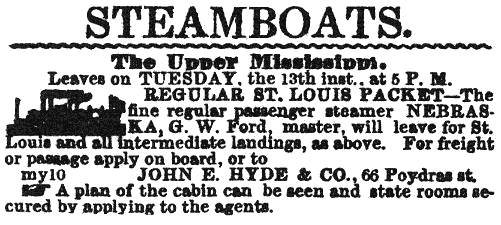
Ad for NEBRASKA, 1856
Many years later Clemens related to his biographer Albert Bigelow Paine his
last trip north from New Orleans to Saint Louis. Hostilities were increasing
between the Union and Confederate forces and river traffic was coming under
inceasing scrutiny. Although Clemens incorrectly recalled the name of the
NEBRASKA as the UNCLE SAM, evidence points to the boat being the NEBRASKA.
In his biography, Paine wrote:
